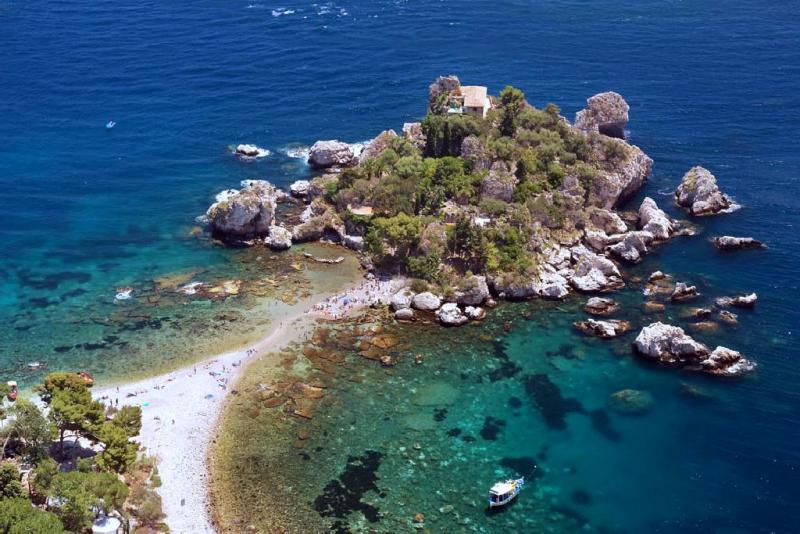For anyone with a sweet tooth, Taormina is a temptation too hard to resist. It is difficult to stroll down the main thoroughfare, Corso Umberto I, or the via Teatro Greco without being drawn into a gelateria with a bewildering array of choices, a sweet shop selling marzipan fruits, fresh kumquats and candied fruit or the pasticceria with cassata and cannoli in the window.
Among the island’s many occupiers, it is the Arabs who must take the credit. Not only did they introduce almonds and many of the fruits, but the Moors discovered that Etna gave a supply of year-round snow to which could be added jasmine or fruits and sugar. They gave this concoction the name sharbath from which comes sherbet or sorbet, the forerunner of the gelato, which Sicilians excel at.
Theatrical Elements
Taormina’s gastronomic delights may be one attraction, but what really brought people to Monte Tauro was theatre. The Greeks built a theatre on the mountain overlooking the sea. The elements of sky, sea and fire were important backdrops in Greek theatre and Monte Tauro was ideally placed to combine all three.

The theatre is carved out of the hillside with the cavea facing north looking along the coastline to a snow-capped, and sometimes fiery, Etna. The acoustics are superb and the theatre is often used in the summer months for dramatic productions and musical performances during an international arts festival.
Waves of Invaders
The Teatro Greco is not the only theatre in town. Just off Piazza Vittorio Emanuele on the Corso is a little church dedicated to Saint Caterina and built in the Spanish Baroque style on the site of a Roman theatre or odeon. Parts of this can be seen in the foundations, but more extensive excavations are behind the church. The odeon was built over a Greek temple, probably one to Aphrodite.
The architectural layers here give a clue to some of Taormina’s invaders. The Palazzo Corvaja next to the church was a Moorish fortress later added to by the Normans, French and the Spanish Aragonese. Like many Sicilian buildings, it is decorated in black lava and white limestone, both readily available nearby. After the Greeks, the town came under Roman and then Byzantine rule. It was the capital of Byzantine Sicily until 902AD when it fell to the Arabs, who destroyed much of the town. It was soon rebuilt, then enjoyed a long period of prosperity under Norman occupation.
Catalan Legacy
Taormina was later drawn to the Aragonese camp and supported the Spanish. This Catalan legacy is reflected in the many 15th-century palazzi along Corso Umberto I, now home to craft shops, boutiques, bars and quality antique shops. Sweet shops and other luxury food shops vie with shops selling leather goods and enamelware.
Moving on to Piazza IX Aprile, you will find the square lined with two churches, the austere Sant’Agostino and the rococo San Guiseppe, and some trendy cafés. The piazza, which has exceptional views over the coast and towards Mount Etna, is the meeting place for Taormina’s chic set. Street artists are found here, often painting the Porta di Mezzo, a clock tower that marks the beginning of the town’s medieval quarter.

The Corso continues to the Piazza del Duomo and Taormina’s rather severe small cathedral, which escaped remodelling during the Renaissance period. However, the piazza did not avoid a makeover completely – there is a Baroque water fountain featuring sea horses, cherubs and a female centaur figure.
The Renaissance town hall on the piazza features the six-pointed Star of David. This was once the Jewish Quarter of town and its streets reveal rich merchants’ houses, often decorated in the black lava stone from Etna.
Above the piazza, looking neglected and in desperate need of repair, is the Palazzo Vecchio, built as a copy of the palazzo of the same name in Venice.
Nooks and Corners
It is worth strolling through some of the steep back streets of Taormina, both to avoid the hordes of summer tourists and to enjoy alluring, quiet courtyards, cool nooks and the occasional cafè. You will find some of the best ristoranti and trattorie here too.
Occasionally the alleyways open out to give great views out over the coast and the steep slopes of Monte Tauro. Wonderful little gardens, little more than collections of terracotta pots, invite you to linger. Here are also found the studios of Taormina’s artists and ceramic artisans.

Illustrious Visitors
Taormina has always attracted the famous, and sometimes the infamous, the rich and the artistic. Goethe was ‘bewitched’ by Taormina and D. H. Lawrence settled there for three years. Both Churchill and Kesselring, though not at the same time, found Taormina to their liking and ate at the same ‘local’.
The Giardino Pubblico was bequeathed to Taormina by the eccentric Florence Trevelyan, ‘invited’ to leave England after a romantic liaison with the Prince of Wales, the future Edward VII.
Gloria Vanderbelt, Joan Crawford, Rita Hayworth and Marlene Dietrich frequently graced the Taormina party scene. Writers and playwrights such as Oscar Wilde, Somerset Maughan and Tennessee Williams were all regular guests at wild parties held at Villa Hauser.
Taormina had an air of genteel Edwardian tweeness that attracted the chic set from the rest of Europe. It was, and still is, distinctly un-Sicilian on the surface, but dig deeper and there beats a Sicilian heart.












